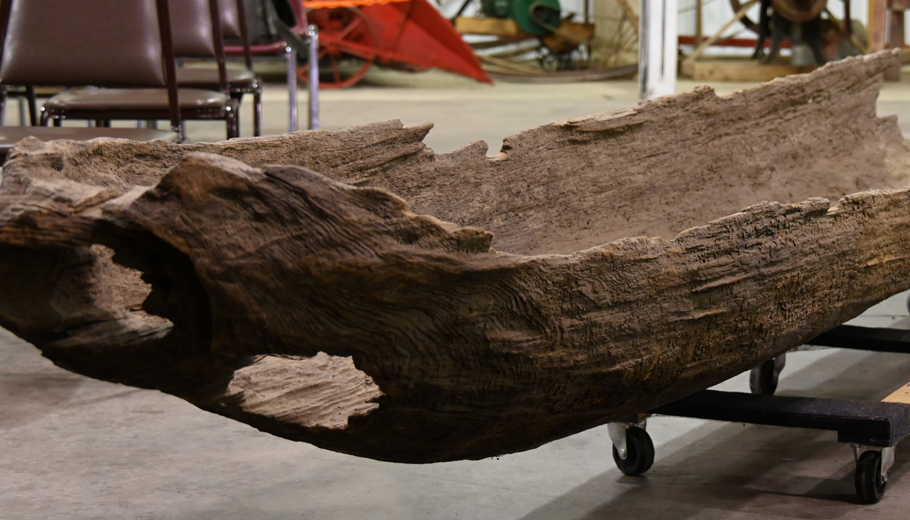
Artifact at Iola Historical Society
By Emily Conroy
Modern scientific tests are revealing the story of a dugout canoe removed from Selmer Lake in 1969.
The canoe was pulled from the lake by Jim Jameson, who eventually gave the canoe to Bob Strand.
Strand was a previous owner of Iola Mills who used the space as a museum, according to Lee Halverson, the Iola Historical Society vice president.
Tom Fucik bought Iola Mills from Strand and recently sold the property. He decided to donate the dugout canoe to the Iola Historical Society, Halverson said.
At a presentation on April 29 by Tamara Thomsen, a maritime archeologist, and Dr. Sissel Schroeder, professor of archeology at the University of Wisconsin-Madison, shared their findings about the canoe and others like it that have been found Wisconsin.
They spoke to a full house at the Machine Shed next to the Iola Historical Society.
A dugout canoe was used in the Midwest throughout the warmer seasons. When Native Americans were unable to use the canoe due to frigid temperatures and ice on waterways, or moving south to warmer temperatures, they would sink the canoe in a lake and come back to retrieve it once the weather warmed.
Schroeder and Thomsen began recording and documenting dugout canoes when a student, Ryan Smazal, decided he wanted to write his college thesis on indigenous watercraft.
Thomsen’s early research
Thomsen was familiar with dugout canoes as she had found a couple dugout canoes in Lake Mendota in Madison. She was diving in the lake and was picking up trash off the bottom when she spotted a dugout canoe. Thomsen said the canoes she found in Lake Mendota have been aged at thousands of years old.
At the start of the project there was only 11 dugout canoes documented in Wisconsin. Today there are 174 and the number is continuing to grow as more people are coming forward with canoes to study.
“As this project expanded we began to realize we are going to have a pretty substantial sample size that might allow us to address more questions, then just simply management of heritage resources,” Schroeder said.
Through radio carbon dating they were able to determine the Selmer Lake dugout canoe is likely well over 100 years old.
“The dugout has very clear metal tool marks on it, and given the timing of metal tools, iron tools being introduced into this region it is most likely that the dates for the dugout fall somewhere in the 1800s, we are pretty sure that it wouldn’t be post 1900,” Schroeder said.
They also found that the keel of the canoe is V-shaped, which is extremely rare for dugout canoes, Thomsen said, the average dugout canoe starts with a V-shape but generally have a flat bottom.
There are only two documented V-shaped dugout canoes in Wisconsin, the Iola dugout canoe is one of them, she said.
The type of wood used was also determined to be red pine, as soft wood is a fairly common material for dugout canoes, Schroeder said.
Before Native Americans were introduced to iron tools they used a combination of fire, stones and shells to make the dugout canoes, Schroeder said.
They would start a fire around the trunk of a tree in order to fell the tree, then they would also use fire to begin to hollow out the trunk, using the shells and stones to start chipping away the inside of the canoe, Schroeder said.
Iron tools were not introduced to Native Americans by the French in the 16th and 17th centuries, Schroeder said.
“Once iron tools were available native peoples quickly adopted them to replace the stone and shell tools they had been using for a millennia using to hollow out logs to make dugouts,” she said.
Schroeder said that fire was still used, but became less essential to the construction of the dugouts.
The Selmer Lake dugout canoe is on display at the Machine Shed in Iola and people can visit on Saturdays from noon until 3 p.m. from June until August, Halverson said.
Schroeder encourages anyone who has a dugout canoe or knows someone who does to reach out to them at [email protected] to report the watercraft and to get it documented.
